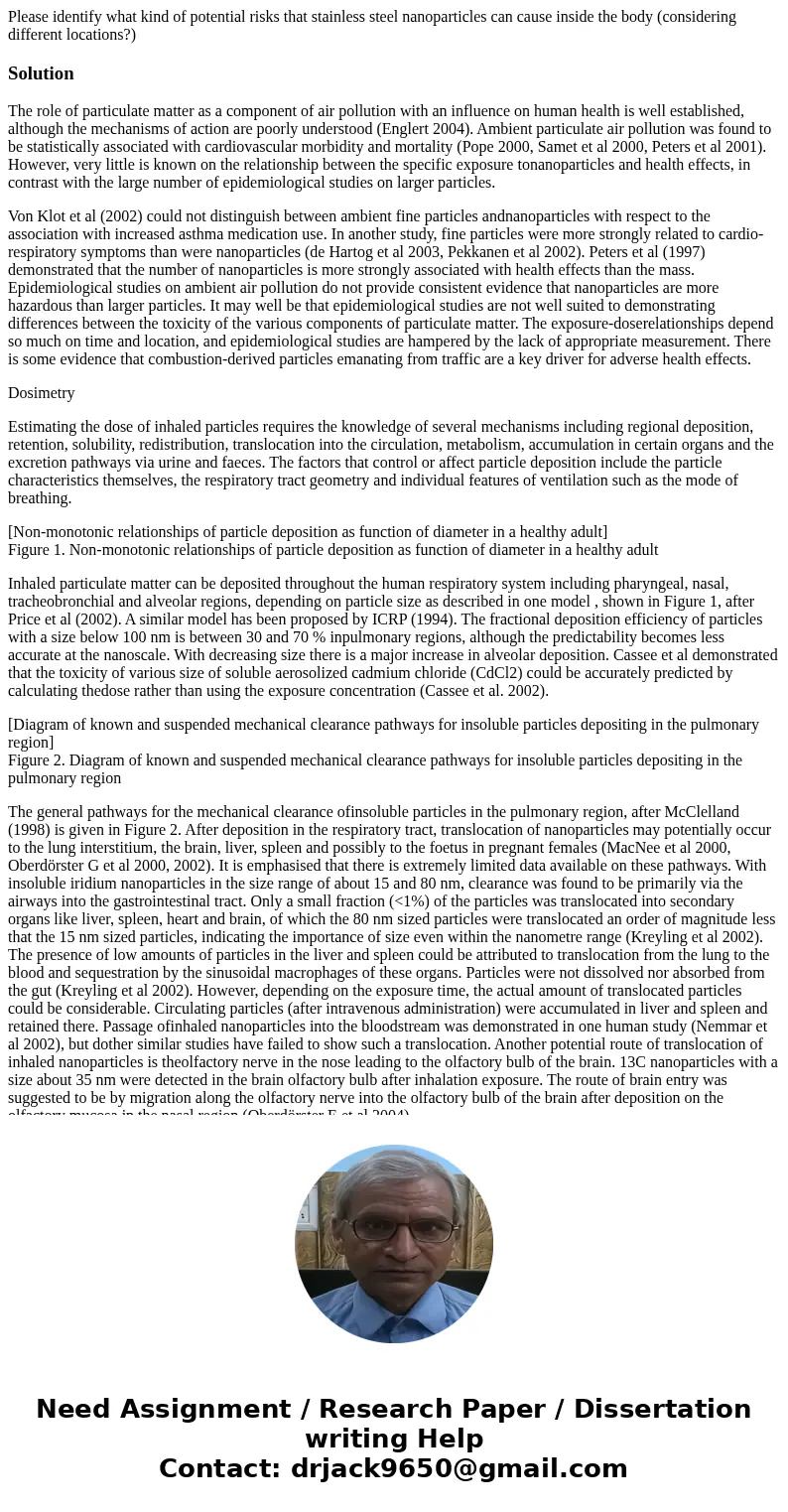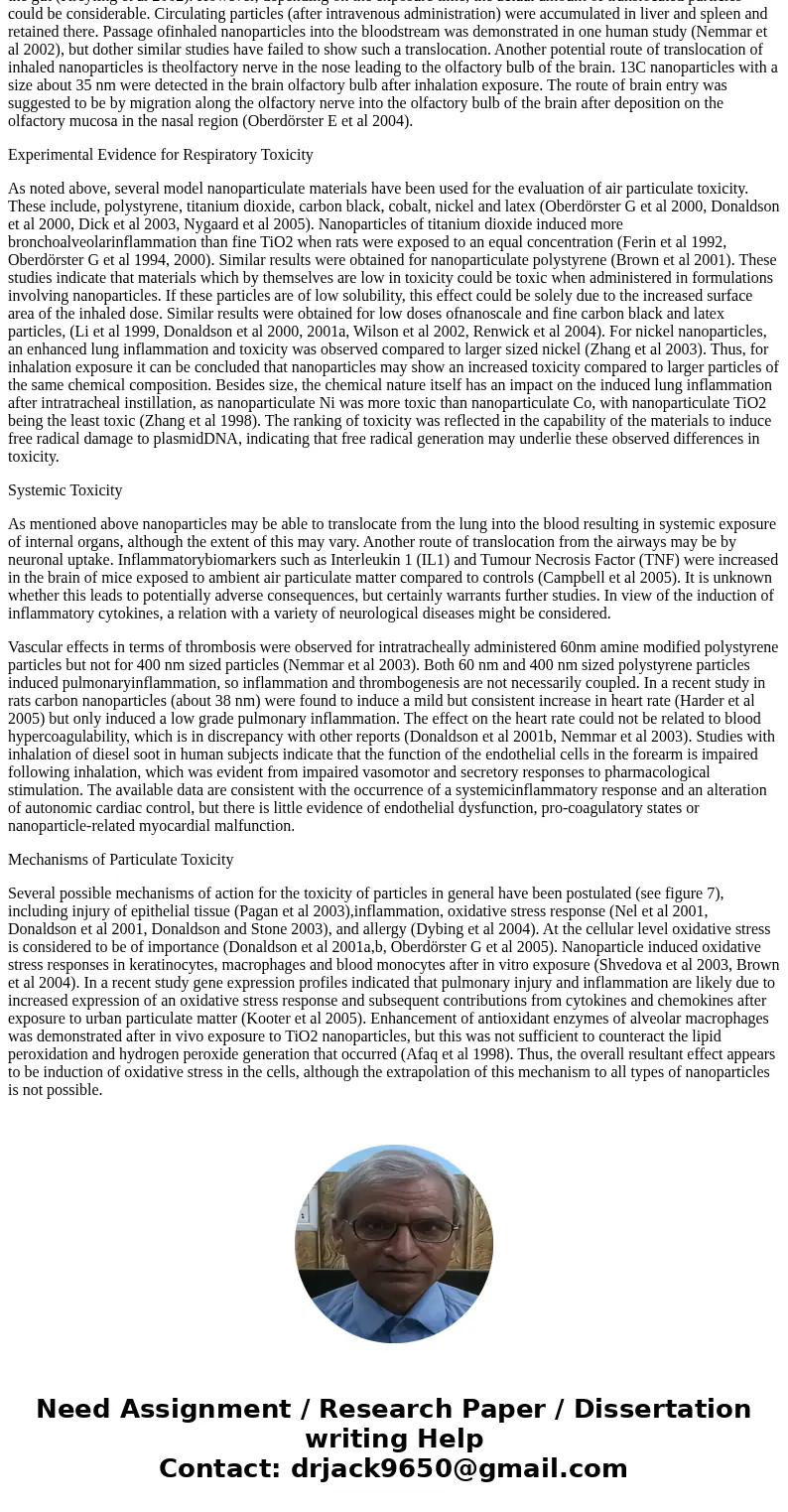Please identify what kind of potential risks that stainless
Solution
The role of particulate matter as a component of air pollution with an influence on human health is well established, although the mechanisms of action are poorly understood (Englert 2004). Ambient particulate air pollution was found to be statistically associated with cardiovascular morbidity and mortality (Pope 2000, Samet et al 2000, Peters et al 2001). However, very little is known on the relationship between the specific exposure tonanoparticles and health effects, in contrast with the large number of epidemiological studies on larger particles.
Von Klot et al (2002) could not distinguish between ambient fine particles andnanoparticles with respect to the association with increased asthma medication use. In another study, fine particles were more strongly related to cardio-respiratory symptoms than were nanoparticles (de Hartog et al 2003, Pekkanen et al 2002). Peters et al (1997) demonstrated that the number of nanoparticles is more strongly associated with health effects than the mass. Epidemiological studies on ambient air pollution do not provide consistent evidence that nanoparticles are more hazardous than larger particles. It may well be that epidemiological studies are not well suited to demonstrating differences between the toxicity of the various components of particulate matter. The exposure-doserelationships depend so much on time and location, and epidemiological studies are hampered by the lack of appropriate measurement. There is some evidence that combustion-derived particles emanating from traffic are a key driver for adverse health effects.
Dosimetry
Estimating the dose of inhaled particles requires the knowledge of several mechanisms including regional deposition, retention, solubility, redistribution, translocation into the circulation, metabolism, accumulation in certain organs and the excretion pathways via urine and faeces. The factors that control or affect particle deposition include the particle characteristics themselves, the respiratory tract geometry and individual features of ventilation such as the mode of breathing.
[Non-monotonic relationships of particle deposition as function of diameter in a healthy adult]
Figure 1. Non-monotonic relationships of particle deposition as function of diameter in a healthy adult
Inhaled particulate matter can be deposited throughout the human respiratory system including pharyngeal, nasal, tracheobronchial and alveolar regions, depending on particle size as described in one model , shown in Figure 1, after Price et al (2002). A similar model has been proposed by ICRP (1994). The fractional deposition efficiency of particles with a size below 100 nm is between 30 and 70 % inpulmonary regions, although the predictability becomes less accurate at the nanoscale. With decreasing size there is a major increase in alveolar deposition. Cassee et al demonstrated that the toxicity of various size of soluble aerosolized cadmium chloride (CdCl2) could be accurately predicted by calculating thedose rather than using the exposure concentration (Cassee et al. 2002).
[Diagram of known and suspended mechanical clearance pathways for insoluble particles depositing in the pulmonary region]
Figure 2. Diagram of known and suspended mechanical clearance pathways for insoluble particles depositing in the pulmonary region
The general pathways for the mechanical clearance ofinsoluble particles in the pulmonary region, after McClelland (1998) is given in Figure 2. After deposition in the respiratory tract, translocation of nanoparticles may potentially occur to the lung interstitium, the brain, liver, spleen and possibly to the foetus in pregnant females (MacNee et al 2000, Oberdörster G et al 2000, 2002). It is emphasised that there is extremely limited data available on these pathways. With insoluble iridium nanoparticles in the size range of about 15 and 80 nm, clearance was found to be primarily via the airways into the gastrointestinal tract. Only a small fraction (<1%) of the particles was translocated into secondary organs like liver, spleen, heart and brain, of which the 80 nm sized particles were translocated an order of magnitude less that the 15 nm sized particles, indicating the importance of size even within the nanometre range (Kreyling et al 2002). The presence of low amounts of particles in the liver and spleen could be attributed to translocation from the lung to the blood and sequestration by the sinusoidal macrophages of these organs. Particles were not dissolved nor absorbed from the gut (Kreyling et al 2002). However, depending on the exposure time, the actual amount of translocated particles could be considerable. Circulating particles (after intravenous administration) were accumulated in liver and spleen and retained there. Passage ofinhaled nanoparticles into the bloodstream was demonstrated in one human study (Nemmar et al 2002), but dother similar studies have failed to show such a translocation. Another potential route of translocation of inhaled nanoparticles is theolfactory nerve in the nose leading to the olfactory bulb of the brain. 13C nanoparticles with a size about 35 nm were detected in the brain olfactory bulb after inhalation exposure. The route of brain entry was suggested to be by migration along the olfactory nerve into the olfactory bulb of the brain after deposition on the olfactory mucosa in the nasal region (Oberdörster E et al 2004).
Experimental Evidence for Respiratory Toxicity
As noted above, several model nanoparticulate materials have been used for the evaluation of air particulate toxicity. These include, polystyrene, titanium dioxide, carbon black, cobalt, nickel and latex (Oberdörster G et al 2000, Donaldson et al 2000, Dick et al 2003, Nygaard et al 2005). Nanoparticles of titanium dioxide induced more bronchoalveolarinflammation than fine TiO2 when rats were exposed to an equal concentration (Ferin et al 1992, Oberdörster G et al 1994, 2000). Similar results were obtained for nanoparticulate polystyrene (Brown et al 2001). These studies indicate that materials which by themselves are low in toxicity could be toxic when administered in formulations involving nanoparticles. If these particles are of low solubility, this effect could be solely due to the increased surface area of the inhaled dose. Similar results were obtained for low doses ofnanoscale and fine carbon black and latex particles, (Li et al 1999, Donaldson et al 2000, 2001a, Wilson et al 2002, Renwick et al 2004). For nickel nanoparticles, an enhanced lung inflammation and toxicity was observed compared to larger sized nickel (Zhang et al 2003). Thus, for inhalation exposure it can be concluded that nanoparticles may show an increased toxicity compared to larger particles of the same chemical composition. Besides size, the chemical nature itself has an impact on the induced lung inflammation after intratracheal instillation, as nanoparticulate Ni was more toxic than nanoparticulate Co, with nanoparticulate TiO2 being the least toxic (Zhang et al 1998). The ranking of toxicity was reflected in the capability of the materials to induce free radical damage to plasmidDNA, indicating that free radical generation may underlie these observed differences in toxicity.
Systemic Toxicity
As mentioned above nanoparticles may be able to translocate from the lung into the blood resulting in systemic exposure of internal organs, although the extent of this may vary. Another route of translocation from the airways may be by neuronal uptake. Inflammatorybiomarkers such as Interleukin 1 (IL1) and Tumour Necrosis Factor (TNF) were increased in the brain of mice exposed to ambient air particulate matter compared to controls (Campbell et al 2005). It is unknown whether this leads to potentially adverse consequences, but certainly warrants further studies. In view of the induction of inflammatory cytokines, a relation with a variety of neurological diseases might be considered.
Vascular effects in terms of thrombosis were observed for intratracheally administered 60nm amine modified polystyrene particles but not for 400 nm sized particles (Nemmar et al 2003). Both 60 nm and 400 nm sized polystyrene particles induced pulmonaryinflammation, so inflammation and thrombogenesis are not necessarily coupled. In a recent study in rats carbon nanoparticles (about 38 nm) were found to induce a mild but consistent increase in heart rate (Harder et al 2005) but only induced a low grade pulmonary inflammation. The effect on the heart rate could not be related to blood hypercoagulability, which is in discrepancy with other reports (Donaldson et al 2001b, Nemmar et al 2003). Studies with inhalation of diesel soot in human subjects indicate that the function of the endothelial cells in the forearm is impaired following inhalation, which was evident from impaired vasomotor and secretory responses to pharmacological stimulation. The available data are consistent with the occurrence of a systemicinflammatory response and an alteration of autonomic cardiac control, but there is little evidence of endothelial dysfunction, pro-coagulatory states or nanoparticle-related myocardial malfunction.
Mechanisms of Particulate Toxicity
Several possible mechanisms of action for the toxicity of particles in general have been postulated (see figure 7), including injury of epithelial tissue (Pagan et al 2003),inflammation, oxidative stress response (Nel et al 2001, Donaldson et al 2001, Donaldson and Stone 2003), and allergy (Dybing et al 2004). At the cellular level oxidative stress is considered to be of importance (Donaldson et al 2001a,b, Oberdörster G et al 2005). Nanoparticle induced oxidative stress responses in keratinocytes, macrophages and blood monocytes after in vitro exposure (Shvedova et al 2003, Brown et al 2004). In a recent study gene expression profiles indicated that pulmonary injury and inflammation are likely due to increased expression of an oxidative stress response and subsequent contributions from cytokines and chemokines after exposure to urban particulate matter (Kooter et al 2005). Enhancement of antioxidant enzymes of alveolar macrophages was demonstrated after in vivo exposure to TiO2 nanoparticles, but this was not sufficient to counteract the lipid peroxidation and hydrogen peroxide generation that occurred (Afaq et al 1998). Thus, the overall resultant effect appears to be induction of oxidative stress in the cells, although the extrapolation of this mechanism to all types of nanoparticles is not possible.


 Homework Sourse
Homework Sourse